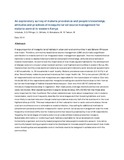| dc.description.abstract | A large proportion of mosquito larval habitats in urban and rural communities in sub-Saharan Africa are man-made. Therefore, community-based larval source management (LSM) could make a significant contribution to malaria control in an integrated vector management approach. Here we implemented an exploratory study to assess malaria prevalence and people's knowledge, attitudes and practices on malaria transmission, its control and the importance of man-made aquatic habitats for the development of disease vectors in one peri-urban lowland and two rural highland communities in western Kenya. We implemented monthly cross-sectional malaria surveys and administered a semi-structured questionnaire in 90 households, i.e. 30 households in each locality. Malaria prevalence was moderate (3.2-6.5%) in all sites. Nevertheless, residents perceived malaria as their major health risk. Thirty-two percent (29/90) of all respondents did not know that mosquitoes are responsible for the transmission of malaria. Over two-thirds (69/90) of the respondents said that mosquito breeding site could be found close to their homes but correct knowledge of habitat characteristics was poor. Over one-third (26/67) believed that immature mosquitoes develop in vegetation. Man-made pools, drainage channels and burrow pits were rarely mentioned. After explaining where mosquito larvae develop, 56% (50/90) felt that these sites were important for their livelihood. Peri-urban residents knew more about mosquitoes' role in malaria transmission, could more frequently describe the larval stages and their breeding habitats, and were more likely to use bed nets even though malaria prevalence was only half of what was found in the rural highland sites (p<0.05). This was independent of their education level or socio-economic status. Hence rural communities are more vulnerable to malaria infection, thus calling for additional methods to complement personal protection measures for vector control. Larval source management was the most frequently mentioned (30%) tool for malaria control but was only practiced by 2 out of 90 respondents. Targeting the larval stages of malaria vectors is an underutilized malaria prevention measure. Sustainable elimination or rendering of such habitats unsuitable for larval development needs horizontally organized, community-based programs that take people's needs into account. Innovative, community-based training programs need to be developed to increase people's awareness of man-made vector breeding sites and acceptable control methods need to be designed in collaboration with the communities. | en |

